There are different design options for island bus stops depending on the local context of the corridor: full width island, narrow width, nominal width, linear cycleway with boarding island, and bus stops with two-way cycleways. These are each discussed in turn.
The full-width island bus stop layout (see the figure below) provides bus passengers with a separate place to wait and means they do not have to cross the cycleway when transitioning between the waiting area and the bus.
Clear glazing in the rear and sides of the bus shelter will ensure visibility between pedestrians and cyclists behind the bus stop. As noted in relation to two-way bidirectional cycleways, it is recommended that the shelter is clear on all sides.
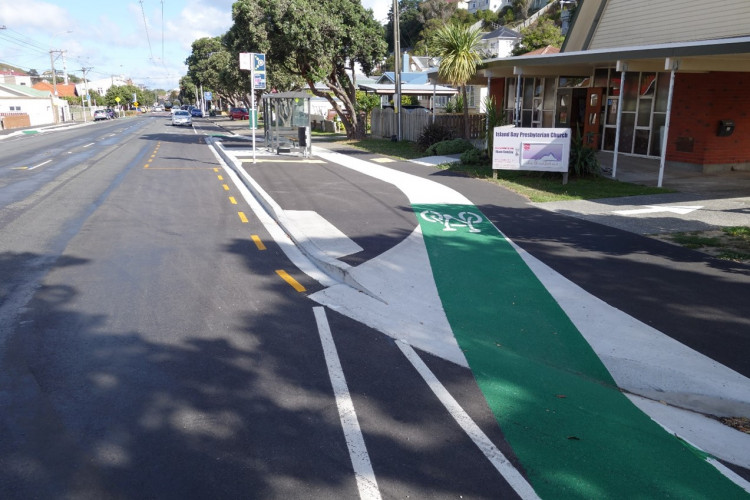
Full-width island bus stop. Note the lane markings and residual footpath widths are not optimal. (Source: Simon Kennett)
In terms of the width of the island:
The preferred width of the cycleway depends on its type (separated or non-separated) and use (one-way or two-way). Minimum widths are set out in Cycling Network Guidance.
Cycling Network Guidance: Separated cycleways
The absolute minimum width of a:
A limit line in the cycleway is needed before the pedestrian crossing. It should be set back 2m. A give way marking before the limit line will further enhance pedestrian priority.
If the island has room to provide passenger waiting facilities (for example, a shelter or seat), then a minimum of 300mm should separate the obstacle (the waiting facility) from the cycleway (see the figure below). The preferred minimum separation is 500mm.
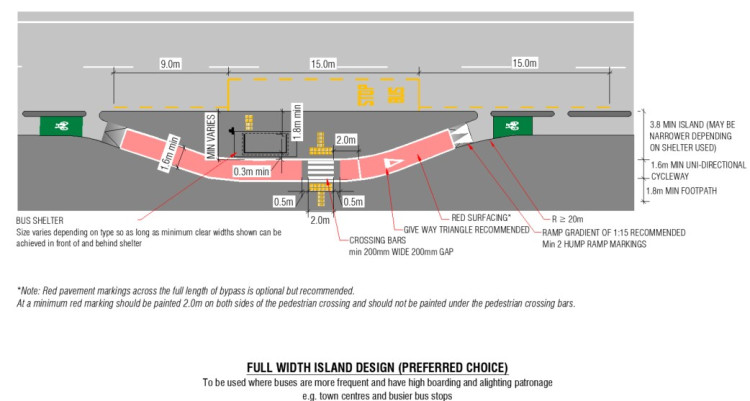
Full-width island design preferred for one-way cycleways. View larger image [JPG, 142 KB]
A narrow-width island bus stop is where the island does not have enough room for passenger waiting facilities (for example, a bus shelter or seat) and such facilities are provided, if at all, on the footpath side of the cycleway (see the figures below).
If encouraging bus passengers to wait on the footpath, care should be taken to ensure sight lines between the waiting area and the approaching bus are not restricted (for example, parked vehicles and foliage). When sight lines are limited, this increases the risk to a person waiting on the island which may impact on their safety and amenity when using public transport.
The island should be wide enough to accommodate the deployment of an accessible ramp from equipped buses and allow a person using a wheelchair enough space to clear the ramp prior to moving across the cycleway. Care must be taken to ensure any design does not limit accessible boarding and alighting at the bus stop.
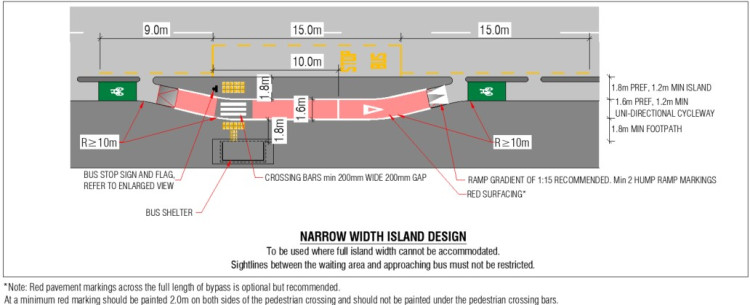
Narrow-width island design for one-way cycleway. View larger image [JPG, 153 KB]

Narrow-width island design (enlarged view). View larger image [JPG, 107 KB]
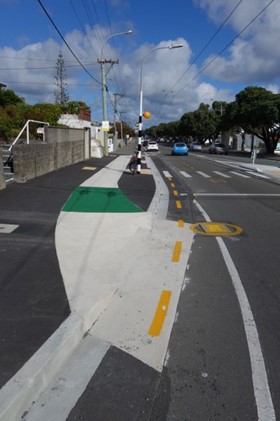
Narrow-width island bus stop. (Source: Simon Kennett)
The width of a narrow island can vary slightly, depending on the situation. The preferred width is 1.8m, but this may be reduced to 1.5m if less space is available. The absolute minimum width is 1.2m.
Consider the need for wheelie bin collection from the island, factoring in local land use characteristics such as residential density.
For more guidance on wheelie bin collection, see:
Good Practice Guidelines for the Collection of Waste on Cycle Lanes (external link)
The preferred width of the cycleway depends on its type (separated or non-separated) and use (one-way or two-way). Minimum widths are set out in Cycling Network Guidance.
The absolute minimum width of a:
For more information, see:
Cycling Network Guidance: Separated cycleways
Where a full-width or narrow-width island cannot be provided between the cycleway and the road, bus passengers enter and exit the bus directly through the cycleway using a nominal-width island (see the figures below).
A nominal-width island increases the conflict risk between bus passengers and people cycling because bus passengers must cross the cycleway when boarding or alighting and the buffer area between the kerb and cycleway is quite minimal. This option potentially impedes access for disabled people and people who feel anxious about crossing the cycleway when alighting or boarding a bus. A risk exists with this design that the quality of service for buses will be reduced with significant volumes of cyclists, creating accessibility problems for people who use wheelchairs.
A nominal-width island should have no grade separation between pedestrians and cyclists for three reasons.
Consider using a nominal-width island only if:
Do not use a nominal-width island if the:
The width of a one-way cycleway must be at least 1.2m (an absolute minimum). Provide an additional 0.8m between the cycleway and the bus stop, so a person in a wheelchair can be accommodated on the island.
Consider the need for wheelie bin collection and implications on the width and length of the island.
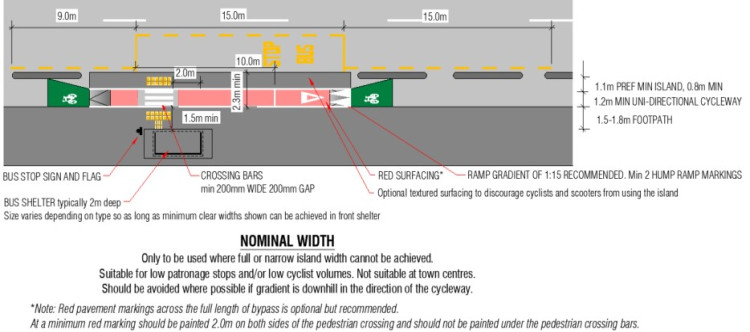
Nominal-width island design. View larger image [JPG, 98 KB]
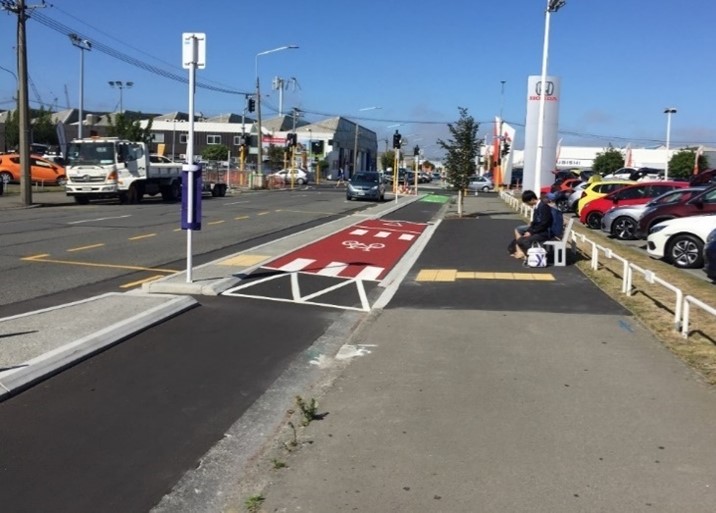
Nominal-width island bus stop (one-way cycleway), Christchurch. Note: Red under white crossing markings is not recommended. (Source: Waka Kotahi)
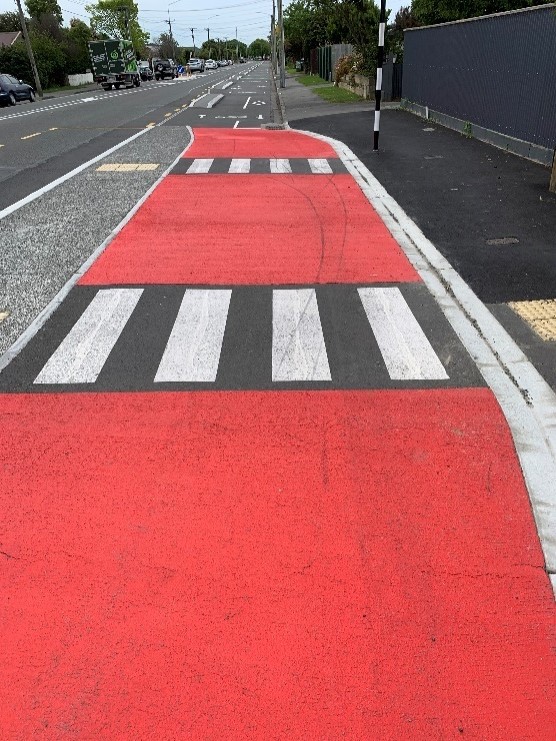
Nominal-width island bus stop (two-way cycleway), Christchurch. Note: the Belisha beacon is not recommended. (Source: Simon Kennett)
Where a cycleway is next to parallel parking, the design of the bus stop is similar to that of the full-width island design, but the on-street parking provides buffer space for a bus boarder. Therefore, cyclists do not need to deviate to bypass the waiting area.
This has the benefit of not reducing the footpath width, and the cycleway width can be maintained throughout its length. The figure below shows the design of a bus stop next to cycleway and parking.
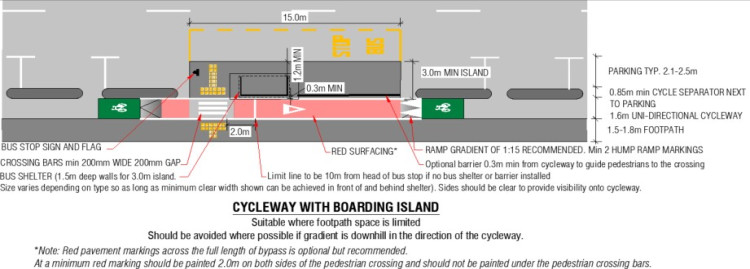
Cycleway with boarding island design. View larger image [JPG, 108 KB]
For this design, the sides of the shelter need to be clear to ensure visibility between cyclists and passengers getting off the bus to cross the cycleway. To guide pedestrians to cross at the crossing, we recommend a fencing barrier is installed on the island adjacent to the cycleway. We recommend this because this design option does not have the horizontal deflection for the cycleway that other design options have. The barrier should be at least 0.3m from the cycleway.
The width of this boarding island is the combined width of the parallel parking space and cycle separator. The standard width for a cycle separator (or flush buffer markings) next to parallel parking is typically 1m with 0.85m being the desirable minimum and 0.7m the absolute minimum. This equates to a 3m wide boarding island, which is adequate to locate a shelter of at least 1.5m deep.
Shelter size can vary depending on its type (for example, cantilever) as long as a clear width of 1.2m can be achieved at the kerb and 0.5m to the cycleway (0.3m minimum).
The island should align with the parallel parking space so the bus can pull in adjacent to the kerb.
Where a bus stop is next to a two-way cycleway, the design considerations are similar as those for bus stops next to one-way cycleways. However, because cyclists will be coming from either direction, there are increased opportunities for conflicts.
The preferred two-way cycleway bus stop design is shown in the figure below. Take care to ensure high visibility between users from both approach directions. The bus shelter needs to account for this by having clear or transparent walls. Street furniture or plantings should not obstruct visibility between pedestrians and cyclists.
The preferred two-way cycleway bus stop design is intended to reduce cyclist speeds by providing a change in level and horizontal deflection and uses red surfacing and crossing bars to alert cyclists to the presence of pedestrians.
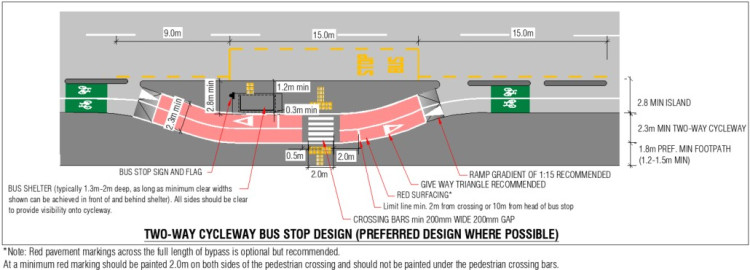
Preferred design for two-way cycleway bus stop. View larger image [JPG, 84 KB]
As with one-way cycleways, a narrow-width island at two-way cycleways increases the conflict risk between bus passengers and cyclists (see the figure below). They have reduced horizontal deflection for cyclists and require pedestrians to cross the cycleway to get from the shelter to the bus.
Consider narrow-width islands only if there are geometric constraints to achieving a full-width island.
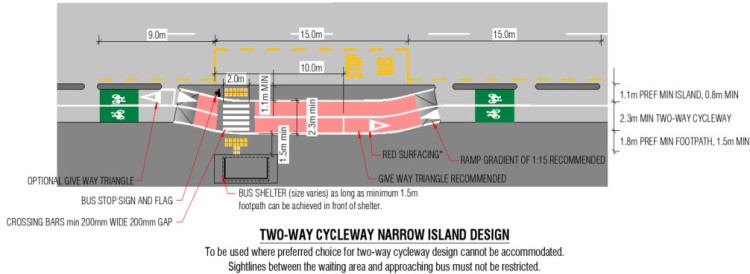
Narrow-width island design for two-way cycleway bus stop. View larger image [JPG, 84 KB]